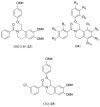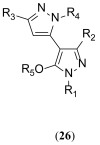Novel NMDA receptor modulators: an update
- PMID: 23009122
- PMCID: PMC3677696
- DOI: 10.1517/13543776.2012.728587
Novel NMDA receptor modulators: an update
Abstract
Introduction: The NMDA receptor is a ligand-gated ion channel that plays a critical role in higher level brain processes and has been implicated in a range of neurological and psychiatric conditions. Although initial studies for the use of NMDA receptor antagonists in neuroprotection were unsuccessful, more recently, NMDA receptor antagonists have shown clinical promise in other indications such as Alzheimer's disease, Parkinson's disease, pain and depression. Based on the clinical observations and more recent insights into receptor pharmacology, new modulatory approaches are beginning to emerge, with potential therapeutic benefit.
Areas covered: The article covers the known pharmacology and important features regarding NMDA receptors and their function. A discussion of pre-clinical and clinical relevance is included, as well. The subsequent patent literature review highlights the current state of the art targeting the receptor since the last review in 2010.
Expert opinion: The complex nature of the NMDA receptor structure and function is becoming better understood. As knowledge about this receptor increases, it opens up new opportunities for targeting the receptor for many therapeutic indications. New strategies and advances in older technologies will need to be further developed before clinical success can be achieved. First-in-class potentiators and subunit-selective agents form the basis for most new strategies, complemented by efforts to limit off-target liability and fine-tune on-target properties.
Figures













References
-
-
Traynelis SF, Wollmuth LP, McBain CJ, et al. Glutamate receptor ion channels: structure, regulation, and function. Pharm Rev. 2010;62(3):405–96. A detailed and historical perspective on ionotropic glutamate receptors covering structure, function and pharmacology.
-
-
- Johnson JW, Ascher P. Glycine potentiates the NMDA response in cultured mouse brain neurons. Nature. 1987;325(6104):529–31. - PubMed
-
- Mayer ML, Westbrook GL, Guthrie PB. Voltage-dependent block by Mg2+ of NMDA responses in spinal cord neurones. Nature. 1984;309(5965):261–63. - PubMed
-
- Nowak L, Bregestovski P, Ascher P, et al. Magnesium gates glutamate-activated channels in mouse central neurones. Nature. 1984;307(5950):462–65. - PubMed
-
- Paoletti P, Neyton J. NMDA receptor subunits: function and pharmacology. Curr Opin Pharmacol. 2007;7(1):39–47. - PubMed
Publication types
MeSH terms
Substances
Grants and funding
LinkOut - more resources
Full Text Sources
Other Literature Sources
Research Materials
